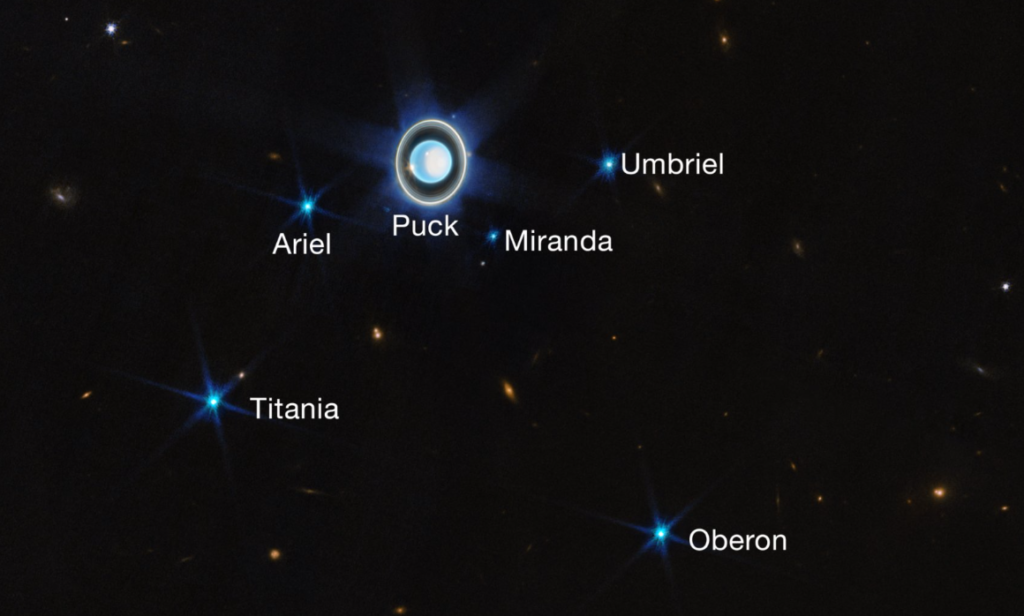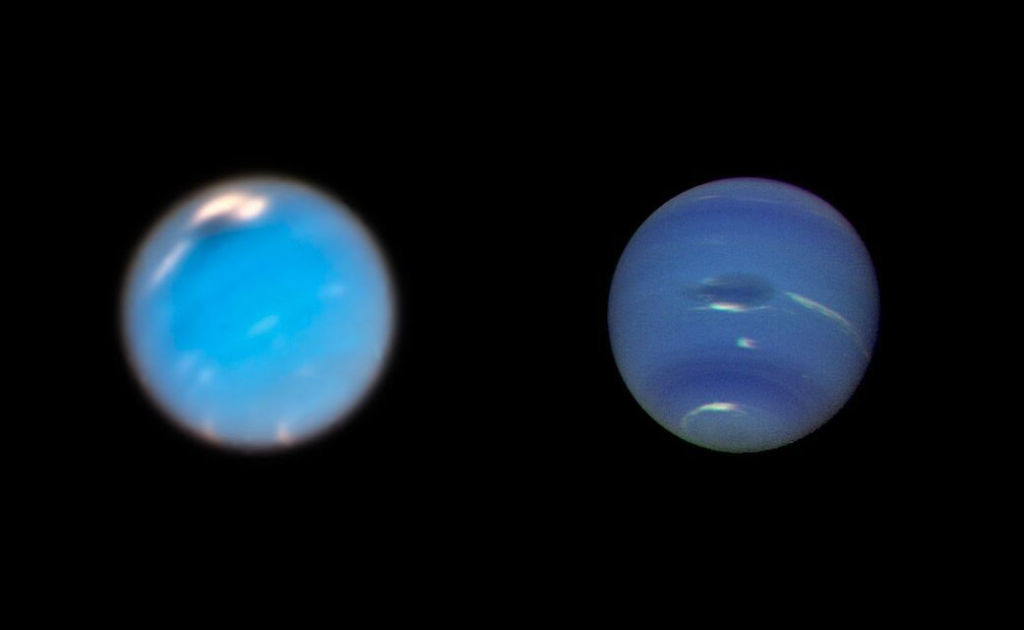
The James Webb Space Telescope Reveals New Images of Uranus
We are approaching an entire year of science operations with the James Webb Space Telescope since it became fully operational in the middle of last year. Most recently, NASA revealed new images of Uranus which show off its rings like never before. These images were taken with the Near Infrared Camera back on February 6th.
In addition to the rings, these new images show off the planet’s moons and various features, unlike any other image. All of which is thanks to the James Webb Space Telescope, the world’s premier space science observatory. Webb is hoping to solve mysteries in our solar system, look beyond to distant worlds around other stars, and probe the mysterious structures and origins of our universe and our place in it.
In the relatively short time Webb has been in operation, it produced some incredible images and data, enough to change how a lot of scientists see the universe. Here I will go more in-depth into the recent Uranus image, what exactly Webb has been up to, what we should expect in the coming months, and more.
New Images

Just yesterday NASA released a few images of Uranus that came from Webb. This zoomed-in image of Uranus, captured by Webb’s Near-Infrared Camera (NIRCam) Feb. 6, 2023, reveals stunning views of the planet’s rings. The planet displays a blue hue in this representative-color image, made by combining data from two filters (F140M, F300M) at 1.4 and 3.0 microns, which are shown here as blue and orange, respectively. This wider view of the Uranian system with Webb’s NIRCam instrument features the planet Uranus as well as six of its 27 known moons (most of which are too small and faint to be seen in this short exposure). A handful of background objects, including many galaxies, are also seen.
The new image features dramatic rings as well as bright features in the planet’s atmosphere. In a quote, NASA said, “The Webb data demonstrates the observatory’s unprecedented sensitivity for the faintest dusty rings, which have only ever been imaged by two other facilities: the Voyager 2 spacecraft as it flew past the planet in 1986, and the Keck Observatory with advanced adaptive optics. This flyby remains the only investigation of Uranus carried out from a short distance and no other visits are planned. Voyager 1 was unable to visit Uranus because the investigation of Saturn’s moon Titan was considered a priority. This trajectory took Voyager 1 out of the plane of the ecliptic, ending its planetary science mission. During its closetest approach, Voyager 2 came within 81,500 km (50,600 mi) of the cloudtops, before continuing its journey to Neptune. The spacecraft studied the structure and chemical composition of Uranus’s atmosphere, including its unique weather.
As the seventh planet from the Sun, Uranus is unique: It rotates on its side, at roughly a 90-degree angle from the plane of its orbit. This causes extreme seasons since the planet’s poles experience many years of constant sunlight followed by an equal number of years of complete darkness. (In total, Uranus takes 84 years to orbit the Sun.) Currently, it is late spring for the northern pole, which is visible here; Uranus’ northern summer will be in 2028. In contrast, when Voyager 2 visited Uranus it was summer at the south pole. The south pole is now on the ‘dark side’ of the planet, out of view and facing the darkness of space.
This infrared image from Webb’s Near-Infrared Camera (NIRCam) combines data from two filters at 1.4 and 3.0 microns, which are shown here in blue and orange, respectively. The planet displays a blue hue in the resulting representative-color image. As with gas giants, ice giants lack a well-defined solid surface. Uranus’s atmosphere is similar to Jupiter’s and Saturn’s in its primary composition of hydrogen and helium, but it contains more “ices” such as water, ammonia, and methane, along with traces of other hydrocarbons
Back in the 80s, when Voyager 2 looked at Uranus, its camera showed an almost featureless blue-green ball in visible wavelengths. With the infrared wavelengths and extra sensitivity of Webb we see more detail, showing how dynamic the atmosphere of Uranus really is. On the right side of the planet there’s an area of brightening at the pole facing the Sun, known as a polar cap. This polar cap is unique to Uranus – it seems to appear when the pole enters direct sunlight in the summer and vanish in the fall; this Webb data will help scientists understand the currently mysterious mechanism. Webb also revealed a surprising aspect of the polar cap: a subtle enhanced brightening at the center of the cap. NASA belives that the sensitivity and longer wavelengths of Webb’s NIRCam may be why we can see this enhanced Uranus polar feature when it has not been seen as clearly with other powerful telescopes like the Hubble Space Telescope and Keck Observatory.
At the edge of the polar cap lies a bright cloud as well as a few fainter extended features just beyond the cap’s edge, and a second very bright cloud is seen at the planet’s left limb. Such clouds are typical for Uranus in infrared wavelengths, and likely are connected to storm activity. This planet is characterized as an ice giant due to the chemical make-up of its interior. Most of its mass is thought to be a hot, dense fluid of “icy” materials – water, methane, and ammonia – above a small rocky core.
Uranus has 13 known rings and 11 of them are visible in this Webb image. Some of these rings are so bright with Webb that when they are close together, they appear to merge into a larger ring. Nine are classed as the main rings of the planet, and two are the fainter dusty rings (such as the diffuse zeta ring closest to the planet) that weren’t discovered until the 1986 flyby by Voyager 2. Scientists expect that future Webb images of Uranus will reveal the two faint outer rings that were discovered with Hubble during the 2007 ring-plane crossing. The Uranian rings are composed of extremely dark particles, which vary in size from micrometres to a fraction of a metre. The rings are probably quite young; the dynamics considerations indicate that they did not form with Uranus. The matter in the rings may once have been part of a moon (or moons) that was shattered by high-speed impacts. From numerous pieces of debris that formed as a result of those impacts, only a few particles survived, in stable zones corresponding to the locations of the present rings.
In addition to getting an incredible view of these rings, Webb also captured many of Uranus’ 27 known moons (most of which are too small and faint to be seen here); the six brightest are identified in the NASA provided wide-view image. Among the Uranian satellites, Ariel appears to have the youngest surface, with the fewest impact craters, and Umbriel the oldest. Miranda has fault canyons 20 km (12 mi) deep, terraced layers, and a chaotic variation in surface ages and features
What’s so interesting is the fact that this was only a short, 12-minute exposure image of Uranus with just two filters. It is just the tip of the iceberg of what Webb can do when observing this mysterious planet. In 2022, the National Academies of Sciences, Engineering, and Medicine identified Uranus science as a priority in its 2023-2033 Planetary Science and Astrobiology decadal survey. Additional studies of Uranus are happening now, and more are planned in Webb’s first year of science operations.
Overall, there are some indications that physical seasonal changes are happening in Uranus. Detailed analysis of the visible and microwave data revealed that the periodical changes of brightness are not completely symmetrical around the solstices, which also indicates a change in the albedo patterns. In the 1990s, as Uranus moved away from its solstice, Hubble and ground-based telescopes revealed that the south polar cap darkened noticeably (except the southern collar, which remained bright), whereas the northern hemisphere demonstrated increasing activity, such as cloud formations and stronger winds, bolstering expectations that it should brighten soon. This indeed happened in 2007 when it passed an equinox: a faint northern polar collar arose, and the southern collar became nearly invisible, although the zonal wind profile remained slightly asymmetric, with northern winds being somewhat slower than southern. A lot of which makes this planet so interesting to NASA and enthusiasts.
As partially mentioned before, the instrument responsible for these images was NIRCam. The Near Infrared Camera (NIRCam) is Webb’s primary imager that covers the infrared wavelength range of 0.6 to 5 microns. NIRCam detects light from: the earliest stars and galaxies in the process of formation, the population of stars in nearby galaxies, as well as young stars in the Milky Way and Kuiper Belt objects. NIRCam is equipped with coronagraphs, instruments that allow astronomers to take pictures of very faint objects around a central bright object, like stellar systems. NIRCam’s coronagraphs work by blocking a brighter object’s light, making it possible to view the dimmer object nearby – just like shielding the sun from your eyes with an upraised hand can allow you to focus on the view in front of you. With the coronagraphs, astronomers hope to determine the characteristics of planets orbiting nearby stars.
Conclusion
NASA just released new images of Uranus that highlight its poles, rings, and moons like never before. With these incredible images only resulting from a short 12 minute exposure, we can expect even more detailed images sometime soon. We will have to wait and see how it progresses and the impact it has on the space industry.
